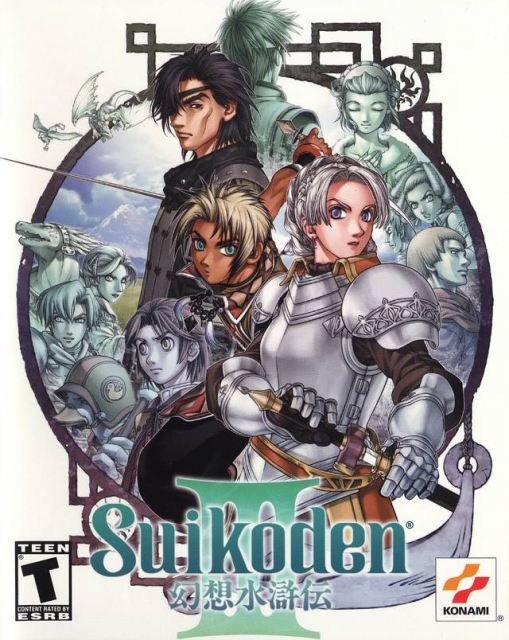Combat takes getting used to, but the story will keep you going.
NOTE: this review was written years ago for GameSpot, but I decided to upload it to GB also. Enjoy!
*************
Konami’s Suikoden RPG series has been a hit in the hearts of many gamers. Its sales, however, tell a different story, especially for Suikoden II, whose timing couldn’t have been worse (it was released around the time Final Fantasy VIII hit store shelves). Fortunately for the fans, Konami realizes how much love the Suikoden series gets, even if they don’t sell a bazillion copies. And fortunately for us, Suikoden III further establishes our love for the series.
One of the big highlights of Suikoden III is its Trinity Sight System, which is hands-down the coolest way to tell a story in an RPG. The TSS allows you to see the same story unfold from the viewpoints of the three main characters: Geddoe, Hugo, and Chris. The TSS also affects gameplay, too; parties never share items, so you don’t magically have access to items that belong to some other party in a remote region. Characters also have their own set of locations, so the entire half of the map might be closed off, depending on who your current point-of-view is. All characters will be able to access all areas, eventually.
Fans of the lightning-fast but ultimately shallow battle system of Suikoden I and II will find a brand-new battle system in Suikoden III. S3’s battle system essentially trades speed for more strategy, but don’t fret; battles still go by quickly, and the handy “Auto” option is still available, so perish the thought of having to manage six characters in a slow battle system. But instead of controlling six characters, you control three--characters fight in pairs, but you can only choose the actions of either character in a pair, but not both. Party members will move around on the battlefield, striking down the enemy (sounds like Grandia). Melee attackers have to worry about distance; a meter determines how far the target is, so slow characters will have trouble closing the gap between themselves and the target, while fast characters will have no problems at all. Magic users will have a meter to indicate how many turns it will take before the spell is unleashed. The more potent the spell, the longer the casting time. The pairing of characters might sound bad at first since you have less control, but as the game goes on, you might find yourself getting accustomed to S3’s unorthodox combat, and maybe even liking it. And hey, random battles are still infrequent—always a bonus.
The duels and strategic battles make a return, but both of them are still as easy as ever. The strategic battles aren’t so event-driven like they were in Suikoden II, but they’re still disappointing. This time, the battles play out like a poor-man’s Ogre Battle. You have zero control over how your units fight, so the outcome is determined solely on whether your guys made the right moves or not. Often, there were times where I just wished there was an “Attack Leader” option, so I could just do away with the unit in an instant. The duels are pretty much the same, except now there’s a meter that tilts in the attacker’s favour if he/she successfully strikes their opponent. When the meter’s on your side, your attack comes first.
Character customization is much improved. In addition to the Runes from previous games, characters can now equip Skills. Each character is proficient with certain Skills, and you can tell which ones by testing their aptitude with each skill. Like Runes, some Skills are unique to certain characters, and they cannot be removed. Skills are upgraded by spending skill points, which are acquired after each battle. Visit a teacher in any town, and spend your points there.
Suikoden III’s main draw, as always, is its 108 characters. Once again, there are 108 characters to collect and use to improve your castle. It’s not difficult to get all of the characters this time around, which will be disappointing for those who liked the challenge of getting them all. There are plenty of returning characters, including some fan favourites and/or their relatives. However, Flik and Viktor are nowhere to be found—go to www.konami.com and write some hate mail if you wish, but Suikoden III is an excellent game without them.
Suikoden games have never been pretty to look at (or sound, to a lesser extent), and Suikoden III maintains that “tradition.” The character models look decent, but they have jerky running animations. The towns look appropriately “busy,” but the dungeons lack creativity. The framerate stutters when there’s a lot of stuff happening on screen, but not to an unplayable state. S3’s soundtrack is largely unmemorable, but it’s not terrible by any means. It’s a good thing that Suikoden III excels where it counts, but there are probably those who want their RPGs to be perfect in every way.
Konami recently halted production of Suikoden III, for unknown reasons (low sales?). Very soon, S3 will become one of those “rare gems” that’s an absolute must-have, but will also sell for bank-busting prices in stores and sites like eBay. Suikoden III is definitely a game that any RPG fan should play, including those new to the series (but it’s recommended that you play S1 and S2 first). Let’s hope Konami continues to prove that some of the best RPGs in the world aren’t going to have the biggest budget.
